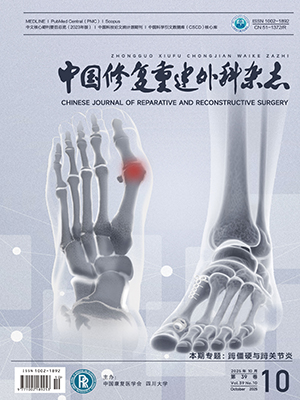Objective To compare the effectiveness of clavicular hook plate fixation in the treatment of acromioclavicular joint dislocation and distal clavicle fractures. Methods A clinical data of 90 patients, who underwent clavicular hook plate fixation between January 2014 and June 2023, was retrospectively analyzed. There were 40 patients with distal clavicle fractures (fracture group) and 50 with acromioclavicular joint dislocations (dislocation group). There was no significant difference in the baseline data of gender, age, cause of injury, side of injury, time from injury to operation, and constituent ratio of osteoporosis patients between the two groups (P>0.05). The time to remove the internal fixators and the occurrence of complications were recorded. Before removing the internal fixator and at 3 months after removing, the visual analogue scale (VAS) score was used to evaluate the degree of pain, and the mobility of the shoulder joint in forward flexion, elevation, and abduction was measured. Before removing the internal fixators, the Constant-Murley score and the University of California, Los Angeles (UCLA) score were used to evaluate the function of the shoulder joint. X-ray films of the shoulder joint were taken during follow-up to observe the occurrence of subacromial osteolysis, acromioclavicular joint osteoarthritis, and distal clavicle bone atrophy. Subgroup comparison was conducted between patients with and without subacromial osteolysis in the two groups. Results All incisions healed by first intention in both groups. All patients were followed up 1-9 years, with a median of 5 years; the difference in follow-up time between the two groups was not significant (P>0.05). During follow-up, subacromial osteolysis occurred in 74 cases, including 41 cases of typeⅠand 33 cases of type Ⅱ, distal clavicle bone atrophy in 15 cases, and acromioclavicular joint osteoarthritis in 8 cases. There were significant differences in the removal time of internal fixators, the incidence of bone atrophy, and the incidence of osteoarthritis between the two groups (P<0.05). There was no significant difference in the incidence of subacromial osteolysis (P>0.05). Before removing the internal fixators, there was no significant difference in VAS score, UCLA score, and Constant-Murley score between the two groups (P>0.05), while there were significant differences in shoulder joint range of motion in all directions (P<0.05). After removing the internal fixators, only the difference in elevation was significant (P<0.05). Within the group comparison, the VAS score and mobility of shoulder joint in abduction and elevation after removing the internal fixators were significantly superior to those before removing (P<0.05). In the fracture and dislocation groups, there was only a significant difference in plate length between the subgroup with and without subacromial osteolysis (P<0.05), while there was no significant difference in the above other indicators (P>0.05). Conclusion Clavicular hook plate is a good choice for treating acromioclavicular dislocation or distal clavicle fractures, but the incidence of subacromial osteolysis is higher, and the degree of bone resorption is more severe in fracture patients. After removal of the internal fixator, the shoulder functions significantly improve. It is recommended to remove the internal fixator as soon as possible within the allowable range of the condition.
Citation:
WU Shengkai, LIU Jiehan, WEI Hongxiang, FANG Kaibin, XIE Yun, ZHENG Lifeng, LIN Jianhua, LIN Jinluan. Comparative study on effectiveness of clavicular hook plate fixation in treatment of acromioclavicular joint dislocation and distal clavicle fractures. Chinese Journal of Reparative and Reconstructive Surgery, 2025, 39(8): 1037-1044. doi: 10.7507/1002-1892.202504077
Copy
Copyright © the editorial department of Chinese Journal of Reparative and Reconstructive Surgery of West China Medical Publisher. All rights reserved




